I have a query which outputs the below

I need to get it to provide a running total so for March it would give whats been paid in Feb and Mar, then for April Feb,Mar & Apr and so on.
Never come across needing this kind of aggregation before in SQL.
I have a query which outputs the below

I need to get it to provide a running total so for March it would give whats been paid in Feb and Mar, then for April Feb,Mar & Apr and so on.
Never come across needing this kind of aggregation before in SQL.
select
[monthid],
[month],
( select sum([paid]) from tbl t2 where t2.[monthid] <= t1.[monthid] ) as paid
from tbl t1
You can check this question and my answer on it. Turns out that recursive common table expression is the fastest method to get running total in SQL Server < 2012.
So in your case it could be something like:
with cte as
(
select T.MonthID, T.Month, T.Paid, T.Paid as Running_Paid
from Table1 as T
where T.MonthID = 118
union all
select T.MonthID, T.Month, T.Paid, T.Paid + C.Running_Paid as Running_Paid
from cte as C
inner join Table1 as T on T.MonthID = C.MonthID + 1
)
select *
from cte
option (maxrecursion 0)
SELECT
T.MonthId
,T.[Month]
,T.Value
,RT.runningTotal
from Table_Name T
CROSS APPLY
(
SELECT SUM(value) as runningTotal
FROM Table_Name
WHERE MonthId <= T.MonthId
) as RT
order by T.MonthId
Test Data
declare @t1 TABLE (Monthid int, month varchar(10), Value decimal(18,2))
insert into @t1
values
(1,'JAN-13',35.00)
,(2, 'FEB-13',35.00)
,(3,'MAR-13',35.00)
,(4,'APR-13',35.00)
,(5,'JUN-13',35.00)
,(6,'Jul-13',35.00)
,(7,'Aug-13',35.00)
SELECT
T.MonthId
,T.[Month]
,T.Value
,RT.runningTotal
from @t1 T
CROSS APPLY
(
SELECT SUM(value) as runningTotal
FROM @t1
WHERE MonthId <= T.MonthId
) as RT
order by T.MonthId
RESULTS
MonthId Month Value runningTotal
1 JAN-13 35.00 35.00
2 FEB-13 35.00 70.00
3 MAR-13 35.00 105.00
4 APR-13 35.00 140.00
5 JUN-13 35.00 175.00
6 Jul-13 35.00 210.00
7 Aug-13 35.00 245.00
Running totals in 2008 are kind of a pain. SQL Fiddle seems to have gone MIA again, but here's a simplistic example of how you can do it.
declare @t1 TABLE (monthid int, mth varchar(10), paid decimal(18,2), running_paid decimal(18,2))
insert into @t1
values (1,'JAN-13',35.00,0)
,(2, 'FEB-13',35.00,0)
,(3,'MAR-13',35.00,0)
declare @running decimal(18,2)
set @running= 0
update @t1 set running_paid = @running, @running= @running+ paid
select
*
from
@t1
Which will give you:
ID MTH PAID RUNNING_PAID
1 JAN-13 35.00 35.00
2 FEB-13 35.00 70.00
3 MAR-13 35.00 105.00
EDIT: As Bogdan Sahlean points out, this is a very funky little process. You could also use a cursor:
declare @t1 TABLE
(monthid int,
mth varchar(10),
paid decimal(18,2)
)
insert into @t1
values (1,'JAN-13',35.00)
,(2, 'FEB-13',35.00)
,(3,'MAR-13',35.00)
declare @running table
(monthid int,
mth varchar(10),
paid decimal(18,2),
running_paid decimal(18,2))
declare c cursor
for select monthid,mth,paid from @t1
open c
declare @Id int
declare @Mth varchar(10)
declare @paid decimal(18,2)
declare @Running_Total decimal(18,2)
set @Running_Total = 0
fetch next from c
into @Id,@Mth,@paid
WHILE @@FETCH_STATUS = 0
begin
fetch next from c
into @Id,@Mth,@paid
select @Running_Total = @Running_Total + @paid --Here's this version's hack for running total
insert into @running values (@Id,@Mth,@paid,@Running_Total)
end
select
*
from
@running
They all kind of stink. This is a lot easier in SQL 2012.